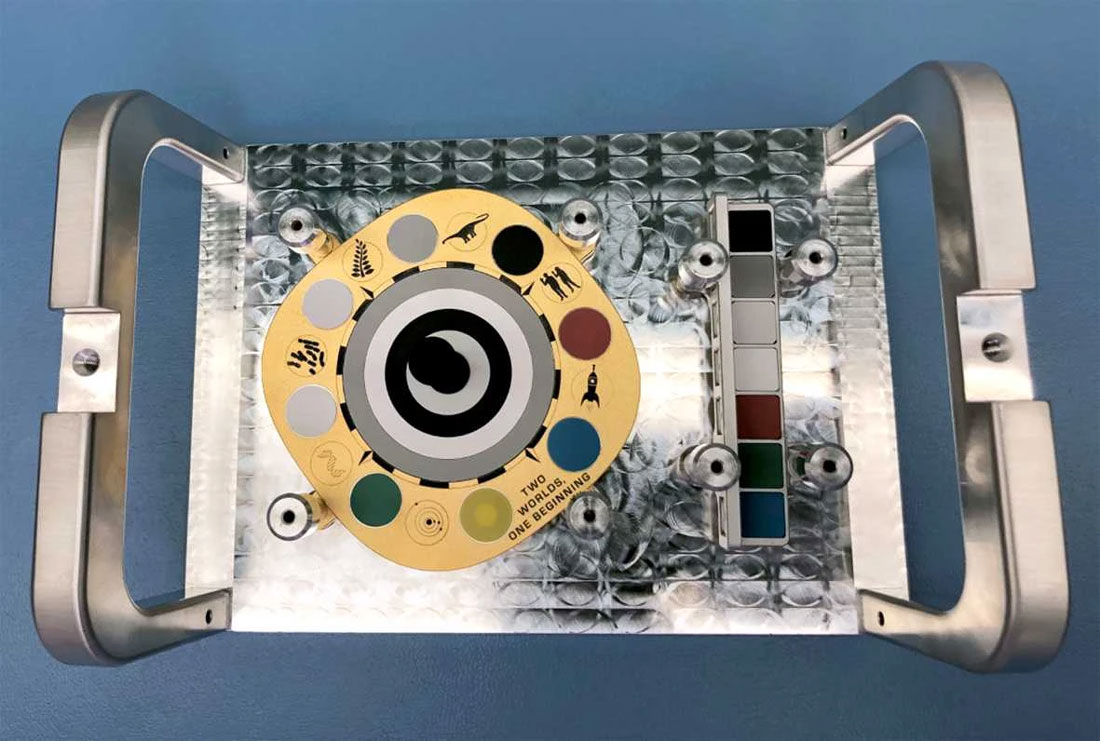The Niels Bohr Institute develops calibration target, now on its way to Mars
Researchers at the Niels Bohr Institute, University of Copenhagen, have developed a color reference for one of the cameras on NASA’s newest Mars mission, the robotic vehicle Perseverance. The vehicle, aka rover, has several cameras installed, but the atmospheric conditions on Mars change the colors recorded, depending on the amount of dust in the atmosphere and the time of acquisition of the photos. For these reasons the cameras need a reference in order to compare or calibrate its images accordingly. This reference has been developed and manufactured in a collaboration between the researchers, the workshop at the Niels Bohr Institute and local businesses, and supported by the Carlsberg Foundation.

The colors change on Mars and so does the possibility to compare recordings
“The calibration target consist of a small base, containing different, well-known ceramic color references”, Kjartan Kinch, Associate professor at the Niels Bohr Institute explains. “Obviously, we take a lot of pictures on Mars, and the camera on the rover can do a little more than your ordinary camera. It has different, so-called narrow-band color filters and can do more color analysis than yellow-red-green-blue. It can “see” UV light and move out into the infrared area as well. When you take a picture, it is the color of the photographed object times the color of the light which determines how we can “read” the photo. What happens is, quite simply, that the camera on the rover records a photo of e.g. rock formations and then, within half an hour or so, the camera turns to record a picture of the calibration target. When we have divided out the color of the light at the recording time, the picture is far more suited for comparison with earlier recordings or recordings from other areas. That is, in short, what our calibration target does”.
What is the purpose of the pictures of rocks and landscapes on Mars?
The rover has a robotic arm with a series of different instruments to investigate elements of the Martian surface. When a rock formation has been investigated for which elements and minerals it contains or other details, the pictures recorded of it can be used for comparison. So if this information is available - like the presence of a certain mineral in a single stone - and it is compared with pictures taken in a much wider perspective out into the landscape on Mars, it is possible to identify other rocks with similar properties of color – but obviously only if the pictures are read and interpreted correctly. Alternatively the camera can be used for identifying stones and rocks with dissimilar properties from former investigations. “If we have the detailed information from a single rock or a single area, we can check its color properties and assume that if the same color properties are present in the landscape, we shall find the same mineralogy here – we can expand detailed knowledge out into the landscape,” says Kjartan Kinch. “Moreover, our photographic information connects to observations from satellites and other instruments, precisely because we take pictures out into the landscape”.
The instrument is a further development of former calibration targets from the Niels Bohr Institute
The researchers and students from the Mars group have taken part in former missions and have improved on the instrument. Along the way a magnetic system, removing the ever present Martian dust from the color references has been developed, keeping the references as clean as possible. The dust on Mars is magnetic, so what started as an experiment on former missions has now become a built in element. “The aluminum base was designed and cut at the workshop of the Niels Bohr Institute, the magnets and ceramics ordered from international companies, the base was silvered and gold plated in Farum, engraved in Ishøj and the whole thing assembled in the Niels Bohr Institute clean room”, Kjartan Kinch explains.
Pictograms on the calibration target
The motto and pictograms seen on the Niels Bohr Institute target are made in collaboration with the team in the USA. There is a tiny stick protruding from the center casting a shadow, just like a solar watch. Solar watches traditionally have a motto, so the instrument was given one as well: “Two worlds, one beginning”. The pictograms show the development of life on Earth from bacterial life over plants and dinosaurs to people launching rockets into space. “It will be one of the most photographed objects on Mars, so we believed a decoration was justified”, Kjartan Kinch says.
The Mars mission Perseverance is part of a bigger mission to send samples back to Earth
This mission is in many ways similar to the very successful mission the rover Curiosity is still undertaking. It landed on Mars in 2012. The new rover is basically built using the same template. What’s new about Perseverance is that it will be covering another area than Curiosity and pick up samples from stones and rocks, later to be picked up by a collaborate ESA-NASA mission and sent back to Earth. So a set of samples from Mars are collected, hopefully telling us a lot about Mars later on. “But first we have to understand the landscape”, says Kjartan Kinch. We have to understand which locations are best suited for collecting samples, to gain maximum benefit from the mission. It is in this context we, at the Niels Bohr Institute, have contributed with a small, but important piece in a larger, scientific puzzle”.
Contact
Morten Bo Madsen, Associate professor
Email: bmadsen@nbi.ku.dk
Phone: +45 35 32 05 15
Kjartan Münster Kinch, Associate professor
Email: kinch@nbi.ku.dk
Phone: +45 28 96 32 86
